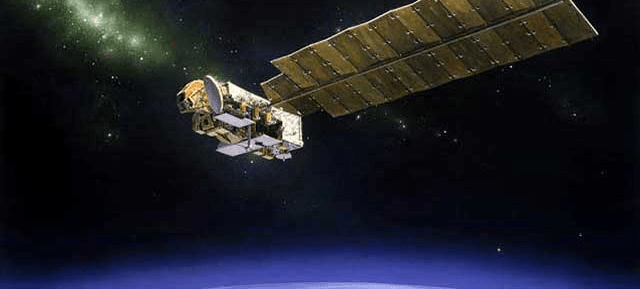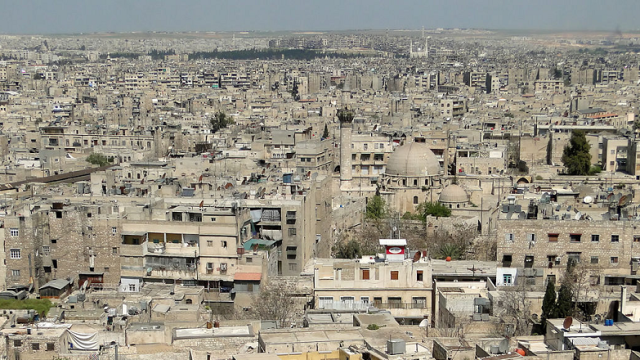Air pollution is decreasing over parts of the Middle East. But researchers say that for most Middle Eastern cities, the clearer air is actually a symptom of conflict, not a sign of progress.
A team of atmospheric scientists led by Jos Lelieveld discovered that in most of the Middle East, nitrogen oxide emissions had been increasing more or less steadily until about 2010. But then that trend suddenly reversed. Using atmospheric data from the Ozone Measurement Instrument on NASA’s Aura research satellite, Lelieveld and his colleagues compared nitrogen oxide emissions over cities in the Middle East with economic data from the World Bank and the timeline of major political and economic shifts in the region.
What they found was actually a little spooky: as war disrupted life in major Middle Eastern cities, the air pollution usually associated with driving, power generation, and industrial applications plummeted.
“It is tragic that some of the observed recent negative NO² trends are associated with humanitarian catastrophes,” wrote the researchers in a paper published this week in the journal Science Advances.
By looking at transient gases in Earth’s atmosphere from a satellite orbiting 700km above the surface, the scientists were able to see the impact of UN and US sanctions on Iranian oil shipping, the movement of refugees from Syria into Lebanon, and the impact of the Islamic State on Iraq.
Better Data Through Chemistry

NASA’s Aura satellite
Nitrogen oxides react with other gases to form ozone, which is bad for local air quality, and nitrogen oxides also contribute to global warming. Although some nitrogen oxides do occur naturally, 58 per cent of the nitrogen oxides in Earth’s atmosphere come from burning fossil fuels, mostly thanks to traffic and industry. Fossil fuels account for nearly all of the nitrogen oxide emissions in the Middle East, though, where there are very few natural sources. That link between nitrogen oxides, traffic and industrial activities makes nitrogen oxide emissions a good way to see, from space, what sorts of economic activities are going in an area.
It’s a great source of local information, too. In fact, studying nitrogen oxide emissions can tell scientists what’s going on in a specific city, or even specific neighbourhoods. That’s because nitrogen oxide emissions usually last less than a day in the atmosphere before dissipating, so the nitrogen oxide over a city is a product of activities in that city, rather than something that drifted in on the wind from elsewhere in the region.
Lelieveld and his colleagues say that gives scientists a chance to study how human events can cause short-term changes in air pollution in relatively small areas.
Cities Under ISIS

The Tigris River in Baghdad. Image credit: Mahmoudalrawi via Wikimedia Commons
Iraq had its share of problems even before ISIS took over parts of the country, but since 2005, its GDP had been increasing steadily by six or seven per cent a year. Meanwhile, energy consumption and carbon dioxide emissions increased by four or five per cent every year and nitrogen oxides, especially in the air over Baghdad, increased more than ten per cent every year — until 2011.
Abruptly, nitrogen oxide emissions started dropping ten per cent every year. After 2011, Iraq’s GDP also dropped, by about 50 per cent. It got even worse in 2013 when the Islamic State moved in. People fled and those who stayed haven’t had good access to gas for driving. Economic activity, which had been on the rise again in the wake of the US military intervention, dropped off sharply.
Over Baghdad, Tikrit, and Samarra, Lelieveld and his colleagues say nitrogen oxide emissions have dropped under the Islamic State’s occupation because the cities’ economies have ground to a halt and many people have fled ISIS rule.
“The armed conflict in this area has left marks, including a decrease in NOx emissions,” they wrote in Science Advances. News reports from the Middle East make it clear that the situation on the ground is bad, but it’s especially chilling that the impact of the Islamic State’s presence is visible even from space.
Human Displacement

Syrian refugees in Lebanon
Nitrogen oxide emissions have dropped in some cities even as they increased in others, a shift which the researchers say “accompanied mass displacements of people in the regions of armed conflict in Syria and Iraq.”
Since a 2011 uprising in Syria led to civil war, Lelieveld and his colleagues say nitrogen oxide emissions over the Syrian cities of Damascus and Aleppo have dropped by 40 or 50 per cent. After ISIS moved into Syria in 2013, about four million Syrians sought refuge in neighbouring countries, and 1.2 million of them ended up in Lebanon. In the cities that took in those refugees, pollution swelled with the added population.
Nitrogen oxide emissions over the Lebanese cities of Beirut and Tripoli had been increasing by just three or four per cent a year until 2013, but when the refugees arrived, emissions increased between 20 and 30 per cent. “The four million refugees from Syria,” wrote Lelieveld and his colleagues, “have had a strong impact on society, accompanied by large changes in NOx emissions.”
For Lelieveld, the findings underscore the severity of the current situation in much of Middle East. “For me personally, I think it is also very important to see that what’s going on in the Middle East is really — is really dramatic,” he told reporters at a press conference yesterday.
Top image: Bernard Gagnon via Wikimedia Commons
